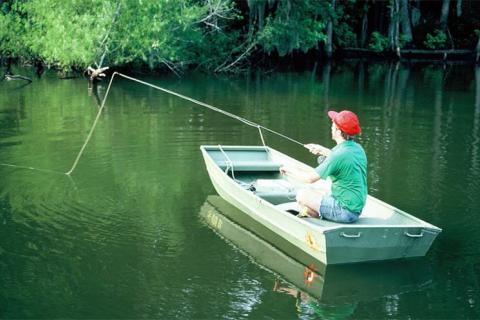
When summer swings in, many anglers feel there’s no more rewarding fish to go after than the humble bluegill. And if you add the aesthetic pleasures of fly fishing, the sport becomes even more appealing.
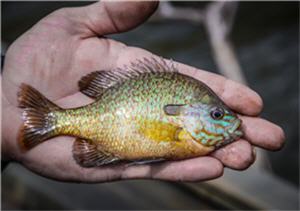 |
| Sunfish and Bluegill will reproduce at alarming rates. |
It’s hard to think of a greater angling pleasure than casting surface flies to a huge school of eager-to-bite panfish. Best of all, you can enjoy this action from spring through fall, for a 9 or 10-month season in most parts of the country.
The Panfish Attraction
Many factors make fly fishing for panfish appealing. For starters, there’s the sheer cooperativeness of the quarry. How many fish species can you target that offer the chance to land dozens of fish virtually every day on the water?
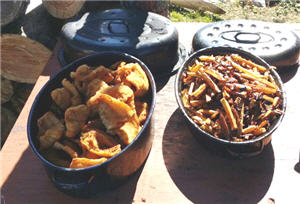 The widespread distribution of panfish also makes them appealing. A variety of cooperative sunfish are usually available within minutes, or at most an hour’s drive of every angler. You can find them in farm ponds, natural lakes, sprawling impoundments, creeks and rivers.
The widespread distribution of panfish also makes them appealing. A variety of cooperative sunfish are usually available within minutes, or at most an hour’s drive of every angler. You can find them in farm ponds, natural lakes, sprawling impoundments, creeks and rivers.
![]() Extra Tip: Panfish are not only widely available, they are also prolific. A female can lay up to 30,000 eggs. Often
Extra Tip: Panfish are not only widely available, they are also prolific. A female can lay up to 30,000 eggs. Often
the problem in many waters is too many panfish. Because of this, you can keep a few for meals and not feel guilty about it. Chill them down on ice and you have the main ingredient for some grand dining.
![]() Tip: How to Steps to Fillet Panfish
Tip: How to Steps to Fillet Panfish
![]() Click here to see a larger view of the panfish fillet guide or print out the How to fillet panfish, bass, perch & crappie graphic here.
Click here to see a larger view of the panfish fillet guide or print out the How to fillet panfish, bass, perch & crappie graphic here.
Fishing for Panfish is Great for Novices and Young Anglers
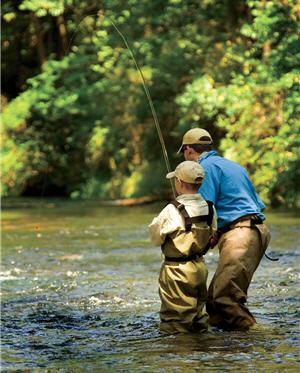 Panfish are also great fish for introducing a youngster or newcomer to fly fishing. While bass can sometimes be difficult and trout are often skittish and persnickety, panfish are generally easy to catch on a fly.
Panfish are also great fish for introducing a youngster or newcomer to fly fishing. While bass can sometimes be difficult and trout are often skittish and persnickety, panfish are generally easy to catch on a fly.
Deliveries can be a bit “sloppy” and the fish won’t flush away like scared quail. In fact, a bug plopping onto the water often draws them over to suck it in. Perhaps it sounds like a cricket or beetle falling in, ringing their dinner bell.
![]() Extra Tip: You don’t need elaborate equipment for catching panfish on flies. A $75-150 outfit will get you started, and only a small selection of flies and extra gear is required.
Extra Tip: You don’t need elaborate equipment for catching panfish on flies. A $75-150 outfit will get you started, and only a small selection of flies and extra gear is required.
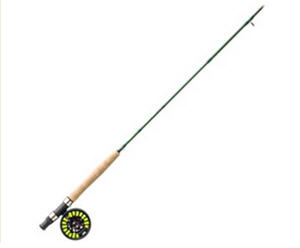 |
| Shop Fly Fishing rods, reels and outfits at Bass Pro Shops |
Late spring and summer fly fishing for panfish is particularly appealing because the quarry is located in thin water at this time. Not only are the fish shallow, you can often see them hovering over their beds or next to weeds and brush. This makes it a richly visual sport as you watch the fish swim over and then gently sip in the fly.
![]() Extra Tip: Look for the first reliable panfish action as waters warm into the low 60’s and even more consistent sport as it reaches the upper 60’s and 70’s.
Extra Tip: Look for the first reliable panfish action as waters warm into the low 60’s and even more consistent sport as it reaches the upper 60’s and 70’s.
![]() Extra Tip: Often spawning is heaviest around the new or full moon, but fish can be caught any time during spring through fall. Even if they are not actively mating you can work the shallows and catch them readily.
Extra Tip: Often spawning is heaviest around the new or full moon, but fish can be caught any time during spring through fall. Even if they are not actively mating you can work the shallows and catch them readily.
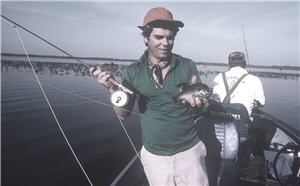 Finding the Fish
Finding the Fish
Locating your quarry involves searching likely shoreline areas until you pinpoint fish on the beds or attractive cover if they are not spawning.
Backwater bays and coves are particularly good bets, but if none are available, look for fish in arms or shallow areas of the main lake or river. Hard bottom is favored for spawning, such as sand, clay or gravel. Muddy bottoms are used as a last resort.
![]() Extra Tip: A tactic some panfishermen use is to probe the bottom with a paddle or long stick, searching for areas that are harder than the surrounding lake floor.
Extra Tip: A tactic some panfishermen use is to probe the bottom with a paddle or long stick, searching for areas that are harder than the surrounding lake floor.
 |
| Hobie Baja Polarized Sunglasses |
With the aid of polarizing sunglasses you can sometimes see the dark-colored fish hovering in the water, in depths of 1-6 feet. You might also see the beds--scoured out areas about 12-18 inches across that males dig out and females deposit eggs in.
![]() Extra Tip: At times you can smell spawning panfish. They give off a sweet aroma like ripe melons.
Extra Tip: At times you can smell spawning panfish. They give off a sweet aroma like ripe melons.
![]() Extra Tip: If you can’t pinpoint fish visually, try areas such as weed beds, points, blowdowns, brush piles, docks, and backwater sloughs on rivers and streams.
Extra Tip: If you can’t pinpoint fish visually, try areas such as weed beds, points, blowdowns, brush piles, docks, and backwater sloughs on rivers and streams.
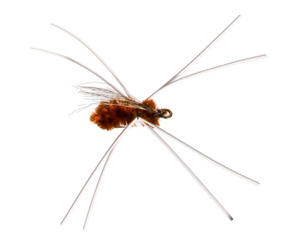 |
| Bett's Bream Madness |
Fly Fishing Tackle & Flies
There’s no need for elaborate on expensive tackle. Go with a rod of 8-9 feet balanced with a 4-7 ounce weight forward or bass bug taper floating line. Add a tapered leader of 7-9 feet with a tippet testing 3-5 pounds and you’re set to go.
Flies for spawning panfish come in many variations. Whatever types you choose, be sure they have small fishing hooks. Sizes 8-12 are perfect.
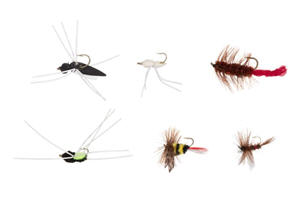 |
| Betts 6-Piece Panfish Fly Kit |
Cork poppers like the Betts Trim Gim Popper Assortment in small sizes are good for big, aggressive panfish. In most situations, however, a floating sponge rubber spider is the best fly to start with. These have flexible rubber band legs that dangle out the sides.
The legs flutter temptingly when you twitch the rod lightly. Since the bugs are soft, fish hold them long enough that setting the hook is easy.
![]() Extra Tip: If the legs on the fly are longer than half an inch out the sides, cut them back with scissors. Often the panfish will grab just the legs and not get hooked if they’re too long.
Extra Tip: If the legs on the fly are longer than half an inch out the sides, cut them back with scissors. Often the panfish will grab just the legs and not get hooked if they’re too long.
 |
| Yellow Stimulator Flies for Fly Fishing |
Another good option for surface fishing is to use regular trout flies. Patterns that work well include the Humpy, Stimulator flies, Royal Wulff, Irresistible, Royal Coachman, Adams and Elk Hair Caddis.
![]() Extra Tip: Trout flies that imitate terrestrials, or land-born insects, are also excellent for bluegills and other panfish. Try cricket, grasshopper, beetle, and ant patterns.
Extra Tip: Trout flies that imitate terrestrials, or land-born insects, are also excellent for bluegills and other panfish. Try cricket, grasshopper, beetle, and ant patterns.
Cast all of these surface offerings over spotted fish or likely cover and let them sit as long as you can stand it. The longer the better. Often strikes will come before you move the fly at all, as it sits there. If no strike comes, twitch it once, wait, and then twitch again before casting to a fresh spot.
After fish stop striking these surface flies or if you can’t spot fish and are probing slightly deeper water, go with subsurface offerings. One of the best is the same sponge rubber spider used in the shallows, but with a split shot crimped on the leader 12-18 inches up the line.
 |
| K & E Stopper Lures Black Gnat Fly Assortment |
Some other good subsurface patterns include the Hare’s Ear nymph, Bitch Creek, K & E Stopper Lures Black Gnat fly, McGinty, Black Ant, and small Woolly Worms. If fish are feeding on baitfish, a streamer such as the Zonker or Clouser Minnow can occasionally draw action. Work those baitfish imitations with short sharp spurts.
The other wet flies and nymphs, as well as the sponge rubber spider with split shot, are best presented with a slow, hand-twist retrieve. You’ll often feel a slight tug or simply weight on the line when a fish nabs one of these offerings. Set the hook quickly.
![]() Extra Tip: A strike indicator near the end of the leader where it joins the fly line can help you detect delicate takes with nymphs and wet flies.
Extra Tip: A strike indicator near the end of the leader where it joins the fly line can help you detect delicate takes with nymphs and wet flies.
![]() Extra Tip: Regardless of what flies you use, after a while the fish will become a bit suspicious and reluctant to strike. Give them a rest by going to another spot. Wait 30 minutes to an hour and they’ll usually be ready to cooperate again when you return.
Extra Tip: Regardless of what flies you use, after a while the fish will become a bit suspicious and reluctant to strike. Give them a rest by going to another spot. Wait 30 minutes to an hour and they’ll usually be ready to cooperate again when you return.
No, a one-half to three-quarter pound panfish won’t pull like a raucous northern pike or jumbo largemouth. But for a quick outing close to home, and fun fly fishing sport, these hand-sized gamefish are hard to beat.
Give them a try and I think you’ll agree.
- 4060 views


